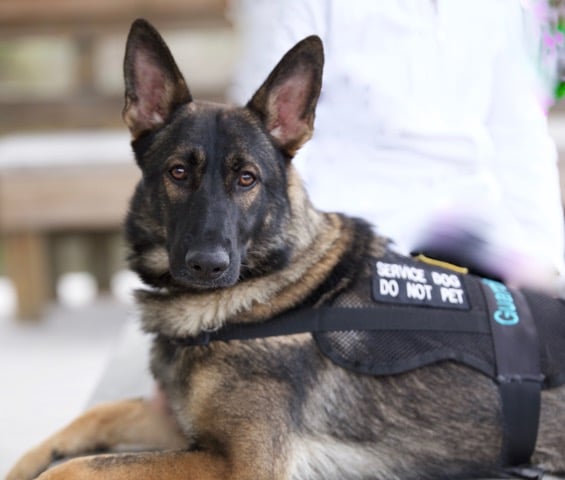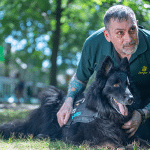At Guardian Angels, mobility dogs are trained based on the needs of the individual. For some people they need help with balance or help getting out of a chair or off the floor. In other cases, mobility issues can be more complex for individuals who need the assistance of a service dog, which is why our training is tailored to the needs of the recipient.
Service dogs are the only type of dog that is protected by federal law under the Americans with Disabilities Act (ADA). This permits service dogs (including mobility service dogs) to be admitted to any space that is public such as grocery stores, shopping malls, public transit, etc. A mobility service dog is considered a type of medical equipment with a heartbeat, and those who have one cannot be denied entry to a public space. Additionally, recipients are not charged a pet fee at a hotel since the service dog is not considered to be a pet.
What Does a Mobility Service Dog Do?
All our dogs are taught to “brace” since there are a number of disabilities and medication that can cause dizziness, to where that person needs to rely on the service dog to support them when that happens.
People can also have issues with their back, knees, or hands and are unable to pick up dropped items or maybe they drop items frequently because their hands don’t function as well as they should. We teach the service dog to pick up dropped items of all kinds such as keys, water bottles, remote controls, a cane, etc.
The dogs are trained to pick these up and hand them back to the individual. Depending on the severity of one’s mobility challenges, there may be further complications doing various tasks. In such cases we may need to teach the dog additional skills such as to open and close drawers and doors, retrieve simple items from the refrigerator, turn on and off lights, etc. To train them to turn lights on and off, we use touch lamps. This helps to prevent the dog from scratching the wall to operate a wall switch, and it makes it easier on the dog physically as they age.
People also need assistance in public as well. For example, someone who is wheelchair bound may need assistance pushing an elevator button or automatic door button outside of a business, which the dogs can also be trained to do.
There is a large spectrum of tasks that we may need to train the dog to do based on the needs of the individual. Mobility service dogs are often paired with a recipient who has a condition such as, but not limited to, vertigo, impaired balance, coordination problems, brain injury, cerebral palsy, muscular dystrophy, a spinal cord injury, Parkinson’s disease, traumatic limb loss, or arthritis. Individuals with physical or developmental disabilities can benefit from a mobility service dog in their daily lives.
Individuals who use prosthetics or assistive devices such as a scooter, cane, walker, or wheelchair can use a mobility service dog to brace and complete a variety of functions throughout the day.
Rather than training our service dogs to learn every single task, we train our service dogs based on the specific mobility needs of our recipients. This allows us to pair our dogs with our recipients more efficiently, rather than leaving our recipients on a longer waiting list.
How Big Should a Mobility Dog Be?
To be a mobility dog, they need to be a substantial size dog such as a Golden Retriever, a Labrador, or a German Shepherd. Those are all good-sized dogs that can help people with balance, open doors, hit elevator buttons versus a small dog who would not be physically capable of doing those things.
While items like a cane can be hard for a dog to pick up, a smaller dog couldn’t complete the task of picking it up and putting it in the recipient’s hand, which is why we need to go with a larger sized dog. While giant breeds such as an Irish wolfhound may seem to be a better choice for a mobility dog, these giant breeds do not live as long as other breeds and are difficult to bring on public transportation such as a plane or bus due to their size.
How Do you Train a Service Dog to Brace?
We first teach them to stand by giving them a command at the same time we are scratching their belly and putting a tiny bit of pressure on their shoulders. You never want to put pressure anywhere else on their back. People can’t brace using any other part of the dog because it can cause injury, it must always be directly over the shoulders. We gradually add more pressure, but a dog can never hold a person’s entire weight. This task is just for some assistance to the person needing aid balancing.
They typically catch on to this command very quickly. Once they have this command down, we will start practicing with them in various positions such as getting up off the ground, up from a chair, or sitting down from a standing position. We work with other maneuvers using this same command to ensure the service dog is trained in a variety of situations.
How Does a Service Dog Know Something is Wrong?
Someone first applies to us through an application process and describes what their disability is and what the challenges are that they are hoping the dog can mitigate for them. Almost all of those challenges, are scent-related, such as seizures, PTSD, diabetes, etc. The person’s body is going through a chemical change before experiencing any of the obvious symptoms of that the disability.
For example, if you’re going to have a seizure, before you have the seizure, your body chemistry is already changing. Dogs have a very sophisticated olfactory system or sense of smell that allows them to notice these chemical changes taking place in your body before they have that end result. While they cannot prevent someone from having a seizure, they can alert them that it is about to happen so the person can put themselves in a safe place or call for help. This helps to prevent the person from falling and becoming injured as their seizure begins. Some people have auras prior to a seizure, while others do not, which can result in catastrophic injuries to the individual.
Another example would be individuals with diabetes. They can have a crash during the night that puts them into a coma, while other family members are sleeping and are unaware. Even those who wear a monitor at night may not hear the beeping as they are sleeping. A service dog can alert to the low blood sugar and persist with their alert until the individual wakes prior to it becoming a crisis.
PTSD also causes chemical changes in the individual that the service dog can alert to by waking up the recipient to help prevent instances of night terrors and or redirecting and calming them prior to anxiety attacks, or other symptoms.
Applying for a Mobility Service Dog
To apply for a mobility service dog from Guardian Angels Medical Service Dogs, you can begin the process by filling out our online form. Once we have received your inquiry form, you will then be sent our full application packet to review and fill out. In your application, we will ask you to tell us about yourself and your disability, how it impacts your daily life, and how a service dog can help you. Our application process is comprehensive and thorough to qualify as a recipient.
Individuals who are eligible for a service dog will travel to Williston, FL to be paired with their dog and to complete a 10-day learning and bonding period to ensure a smooth integration with the service dog once they return home and resume their normal, day-to-day to life. The travel expenses are taken care of by our organization.
We have paired over 400 recipients since we began in 2010 who have become our friends and extended family. You can visit our Meet our Recipients page to learn more about our amazing teams. In addition to mobility, we also train our service dogs to mitigate the challenges of several disorders including diabetic disorders, PTSD, traumatic brain injury, seizure disorder, military sexual trauma and more.
If you have any questions about the service dog application process, our team will be happy to assist you in any way we can! Please contact us today to learn more about our service dogs and how they can help!
- How to Take Advantage of the CTU Patriot Scholarship - April 5, 2024
- Benefits of Service Dogs for Veterans - April 3, 2024
- The Art of Matching: How We Pair Service Dogs - March 19, 2024





